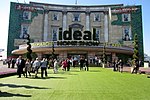West Brompton station

West Brompton is a London Underground, London Overground and National Rail station on Old Brompton Road (A3218) in West Brompton, located in west London, and is on the District line and West London Line (WLL). It is immediately south of the demolished Earls Court Exhibition Centre and west of Brompton Cemetery in the Royal Borough of Kensington and Chelsea. The station is on the Wimbledon branch of the District line between Earl's Court and Fulham Broadway stations. On the WLL, National Rail services are provided by Southern and London Overground, in between Kensington (Olympia) and Imperial Wharf stations. The station's location on the WLL forms a borough boundary and its tracks are shared between Kensington & Chelsea and the London Borough of Hammersmith and Fulham. Since 2000 it has been a Grade II (starting category) Listed Building.
Excerpt from the Wikipedia article West Brompton station (License: CC BY-SA 3.0, Authors, Images).West Brompton station
Roxby Place, London Walham Green (London Borough of Hammersmith and Fulham)
Geographical coordinates (GPS) Address Nearby Places Show on map
Geographical coordinates (GPS)
| Latitude | Longitude |
|---|---|
| N 51.4866 ° | E -0.1957 ° |
Address
Columbia Gardens
Roxby Place
SW6 1EQ London, Walham Green (London Borough of Hammersmith and Fulham)
England, United Kingdom
Open on Google Maps










